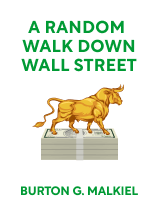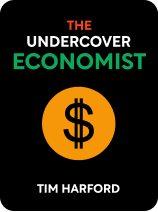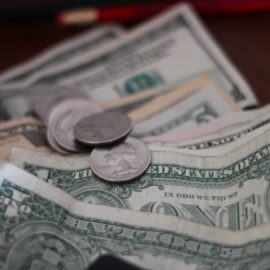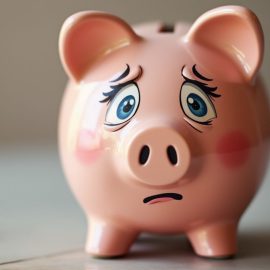

This article gives you a glimpse of what you can learn with Shortform. Shortform has the world’s best guides to 1000+ nonfiction books, plus other resources to help you accelerate your learning.
Want to learn faster and get smarter? Sign up for a free trial here .
Can you predict the stock market? What are some things you should look out for before buying a stock?
It’s difficult to make more money than an average investor in the market. This is because everyone is working with the same information. However, if you know how to predict stock market performance, you can make above-average gains.
In this article, you’ll learn what to look for when trying to gauge what’s going to happen in the stock market as a whole as well as with individual stocks.
How Market Conditions Affect Stock Market Returns
The stock market is a nearly random walk that trends upwards. Generally, as the world economy continues to grow, more people will put their money into the market. This leads to an upwards trend. It’s nearly random because people who are well informed about market conditions can, on aggregate, make a little bit more money than the average investor.
With this in mind, the first step in learning how to predict stock market performance is to understand how different market conditions affect stock prices. In his book A Random Walk Down Wall Street, academic economist and former Wall Street portfolio manager Burton Malkiel discusses how prevailing market conditions have historically affected the stock market during the key periods from the 20th century onwards.
Period I: 1947–1968
The post-WWII period was an advantageous time to be invested in common stocks, less so in bonds. Due in large part to Kennedy’s tax cut in the early ‘60s and government spending to finance the war in Vietnam, employment was high and consumer spending considerable. By 1968, P/Es were north of 18, and stocks were returning 14% annually on average.
However, bonds did not fare nearly as well, posting an average annual return of 1.8% during the period (returns including inflation were actually negative for the period). The main factors contributing to bonds’ poor performance were low initial interest rates—the government had pegged government bonds’ interest rates at a maximum of 2.5% to finance WWII cheaply—and rising interest rates as the years wore on.
Period II: 1969–1981
The financial story of the period between 1969 and 1981 is all about inflation. A concatenation of events—increased demand caused by the Vietnam War stimulus and oil and food shocks in the mid-1970s—resulted in an inflation rate of 6.5% by the end of the 70s. By 1981, inflation had risen to double digits, forcing US Fed Chairman Paul Volcker to raise interest rates significantly. Unfortunately, inflation didn’t immediately slow down, and unemployment spiked (so-called “stagflation”—inflation combined with a stagnating economy).
Returns on stocks and bonds suffered mightily from these tough economic conditions. Although the average annual return on stocks was 5.6% for the period, returns were negative after factoring in inflation. Bonds suffered even worse: Yields in 1969 anticipated a 3% inflation rate; with inflation nearing 8%, returns were utterly wiped out.
Careful readers will wonder: If stocks are supposed to be an inflation hedge, why did they also underperform during this period? The answer lies not in falling earnings or dividends—which, the evidence shows, remained robust—but rather in stocks’ P/E multiples. Simply put, investors were scared—they weren’t willing to pay a premium for solid earnings and dividend growth. Thus stock prices dropped precipitously, slashing returns.
Period III: 1982–early 2000
Considered by Malkiel to be the golden age of asset returns, this era found stock and bond prices adjusting to the inflationary environment and offering attractive returns.
In bonds, average annual rates of return over the period were around 13.6%, a very attractive number. One reason returns were so high was high initial yields (approximately 13%). Because inflation was high at the outset of the period (around 8%) and investors were wary after the bond market catastrophe in the previous period, issuers had to offer high yields to attract investment. When interest rates fell and inflation moderated over the course of the period, bondholders reaped the benefits.
In stocks, average annual rates of return over the period were even better at 18.3%. Again, the poor returns of the previous period created a pessimistic environment wherein assets were undervalued. In 1982, P/E multiples were 8, signaling investor skepticism about companies’ prospects for solid future growth. However, by 2000, P/E multiples had nearly quadrupled to 30. This new investor optimism raised returns to unprecedented heights.
Period IV: 2000–2009
If 1982–early 2000 the high for investors, 2000–2009 was the comedown.
During this period, often referred to as “the lost decade,” average annual returns for stocks were woeful: –6.5%. First there was the bursting of the dot-com bubble, which saw P/E multiples plummet. Then there was the 2008 financial crisis—caused by another bubble, this time in housing—which caused stock prices to decline even further.
One of the few bright spots during this spell was the bond market. Bonds posted an average annual return of 6.4%, offsetting some of the pain of stocks (if you were diversified enough to have bonds in your portfolio).
Period V: 2009–2018
As was the case in 1982, 2009 offered the kind of pessimistic conditions that could—and did—lead to windfall returns. This historical stock market return example shows how returns work in response to a crisis.
During this period, as the economy recovered from the financial crisis, earnings grew by double digits and P/E multiples rose as well, resulting in an average annual return on stocks of 17.5% (just a point behind the golden age of 1982–2000).
Bond returns during this period, though far less sensational than stocks, were still positive at 3.8%.
The above list of historical stock market returns will help you understand what factors contribute to annual rates of stock market return.
A Random Walk Down Wall Street
by Burton G. Malkiel
61 min reading time
212.3k reads
audio version available
Predicting the Performance of Individual Stocks
Economists are hired by investment firms or individuals because they’re generally right about the market’s direction more often than they’re wrong. They know how to predict stock market performance because they understand the future of markets better than the average person.
But what about individual stocks? How do you predict what happens to the share price of a certain company? Is it possible to predict stock performance, in principle?
In his book The Simple Path to Wealth, blogger and financial expert JL Collins writes that investors should beware of the temptation to try and predict stock performance, or to believe an analyst who says he can.
Analysts study industry sectors and companies to try to predict stock performance. But their predictions aren’t typically accurate because they’re based on companies’ own internal performance forecasts (sales predictions), which are guesses. Further, these guesses are often inflated by managers and CEOs so they look better for Wall Street.
As Collins points out, no one knows how to predict stock market performance nor how to pick winning stocks from reading company reports and analyses. Nor can you do so by reading books on valuing stocks like The Intelligent Investor, which was written by Warren Buffett’s mentor in 1949, when there weren’t many managed mutual funds available (so if you wanted to invest, you had to pick stocks). If you’re interested in stocks analysis, the book is worth reading, but it won’t teach you how to predict stock market performance or pick winning stocks.
Running With the Crowd
Similar to Collins, Tim Harford (The Undercover Economist) asserts that trying to learn how to predict stock market performance or to anticipate the share price of individual stocks based on company reports and analyses is futile.
According to Harford, stock prices are the representation of what the market thinks a company will earn in the future. Investors and economists are attempting to judge not the current profitability of a company, but what the current numbers and the state of the economy mean for a company’s future profitability.
When you buy a stock, you’re buying a small part of the company. Theoretically, as a shareholder, you get back part of a company’s profits. In practice, though, shares are more about prospects than profits. When a company makes a profit, it generally reinvests that money into growing its business. Companies spend money on development of a new product or advertising of an existing one. As a shareholder in a company, you’re betting that they’ll have more success with their reinvestments and general growth than the market assumes.
The stock market, then, is less about companies’ fundamentals and more about what other people think of a company. To illustrate this principle, Harford brings up the following example. Two English investors once got into a discussion about the stock price of Grolsch beer. Grolsch had taken off in London, and it was served at every major pub in the city. Grolsch hadn’t found the same foothold in the rest of the country. However, a lot of big investors in England live in London. And many of the investors who live in London assumed, incorrectly, that Grolsch beer is popular everywhere. Thus, these investors thought that Grolsch stock was undervalued, bought a lot of the stock, and drove the price up.
Even if you know that Grolsch isn’t popular in the rest of the country, if you realize that London’s investors are about to buy a large quantity of Grolsch stock, you can get in at a lower price and make a lot of money. The fundamentals of the business catch up with the stock eventually. If Grolsch’s quarterly reports don’t show the growth that investors expect, they might start to sell off. But if you’re playing the stock market, buying and selling companies fairly frequently, the fundamentals of a company don’t matter nearly as much as what other investors think about the quality of a company.
As the above example showed, when playing the market it’s generally safest to run with the crowd. If a lot of people think a company is going to be successful, buy stock in it, because the stock price is likely to go up.
However, sometimes the crowd can get an entire industry wrong. The dot com bubble of the early 2000s happened because investors started investing a lot of money in every internet company, no matter how unsuccessful they looked. At the height of the bubble, the market was pricing internet companies as if they would grow more quickly in the future than any group of companies ever.
Some technology companies, like Microsoft, did have good fundamentals and withstood the bubble better than many. But lots of internet companies didn’t have a clear growth plan, and so, after they couldn’t report growth, came crashing back down to earth. Investors ran with the crowd upwards until the argument for historic growth became untenable. Then, they ran with the crowd on the way down. This sort of groupthink can lead to wild swings in the market.
Price/Earnings Ratio
In addition to the crowd’s sentiment, it’s also important to look at the ratio of the price of the stock to the earnings of a company. Historically, the total price-to-earnings ratio has hung around 16 to one.
Before making a long-term investment in a company, always take a look at the company’s fundamentals. But in particular, if the company’s stock price is more than 16 times greater than its earnings, take an even closer look. This means that the market thinks the company will grow quickly. It also means that it’s due for a crash. Again, in the dot com bubble, the total price-to-earnings ratio of internet companies skyrocketed past 16 to one.
Final Words
No one knows how to predict stock market performance with 100% certainty. That said, you can anticipate what’s going to happen if you’re well-informed about the market conditions. As for individual stock prices, it’s safest to run with the crowd (do people think the company’s share price will go up or down?). Finally, make sure to examine the company’s price-to-earnings ratio: If it’s greater than 16, that company may be due for a crash.
If you enjoyed our article about how to predict stock market performance, here are some suggestions for further reading:
In Fooled by Randomness, former options trader Nassim Nicholas Taleb examines the outsized role luck plays in success, how and why people don’t generally understand luck, and how we can accommodate randomness in our lives once we’re aware of it. Taleb primarily focuses on examples from the world of investing, but his principles are applicable to any field ruled by unpredictability (such as economics or politics) and demonstrate how we’re fooled by randomness in many aspects of our lives.

Want to fast-track your learning? With Shortform, you’ll gain insights you won't find anywhere else .
Here's what you’ll get when you sign up for Shortform :
- Complicated ideas explained in simple and concise ways
- Smart analysis that connects what you’re reading to other key concepts
- Writing with zero fluff because we know how important your time is









